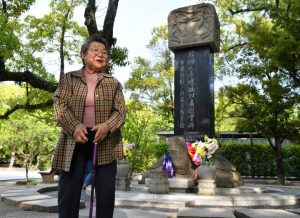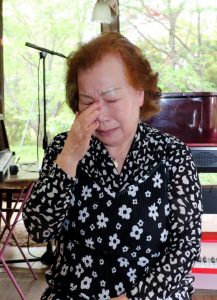Hiroshima Summit, May 19-21: South Korean President to visit Peace Memorial Park, A-bomb survivors living in Japan, South Korea hope president will pledge to abolish nuclear weapons, welcome visit as it will ease victims’ heartache
May 14, 2023
by Kana Kobayashi, Staff Writer
Yoon Suk-yeol will become the first sitting president of South Korea to visit Hiroshima, where he will participate in expanded meetings of the summit of the Group of Seven industrialized nations from May 20. Korean A-bomb survivors living in Japan and South Korea welcome the visit and look forward to the historic day in hopes that he will renew his pledge to abolish nuclear weapons.
“I can’t believe the president is coming to Hiroshima,” said Park Namjoo, 90, expressing her joy. Ms. Park is a South Korean residing in Nishi Ward of Hiroshima. She was exposed to the atomic bombing in Fukushima-cho (now part of Nishi Ward), two kilometers from the hypocenter, at the age of 2. People with their skin hanging off their bodies, black rain that poured from the sky.... Such scenes that she saw under the mushroom cloud are still branded on her memory. “How cruel and ruthless. Nuclear weapons must never be used.”
During his stay in Hiroshima, President Yoon and Prime Minister Fumio Kishida will visit the Monument in Memory of the Korean Victims of the A-bomb in Peace Memorial Park in Naka Ward. The monument was erected near the west end of the Honkawa Bridge in 1970 through the efforts of Korean residents in Japan. It was moved into the park on the opposite side of the river in 1999. In the same year, Keizo Obuchi, the then prime minister, became the first Japanese prime minister to visit the monument.
Jeong Wonsul, 79, said the president’s visit to the monument would ease the heartache of the Korean A-bomb victims, and their souls would be jubilant. Mr. Jeong is the president of the South Korean Atomic Bomb Sufferers Association and a resident of Busan, South Korea. He was exposed to the atomic bombing when he was 1.
When the Korean Peninsula was a colony of Japan, many Koreans crossed the sea to Japan as drafted workers or soldiers or due to poverty and other reasons. Some of them were exposed to the atomic bombings in Hiroshima and Nagasaki. Not much is known about the actual state of Korean victims. One estimation puts the death toll from the Hiroshima bombing at 5,000 to 8,000, and another at 30,000. After Japan’s defeat in the war, some returned to their homeland, while others remained in Japan.
While Korean A-bomb survivors have been emphasizing the inhumanity of nuclear weapons, the South Korean government has maintained a policy of relying on U.S. nuclear weapons with an eye on North Korea, which is advancing its nuclear and missile development programs. Mr. Jeong objects to the expansion of nuclear arms and says nuclear war must not be fought again.
“The atomic bombing caused more pain in my heart than in my body,” said Kim Hwaja, 82, a resident of Kure. She has gone through double discrimination as an A-bomb survivor and as a Korean residing in Japan. As Mr. Yoon is to visit Hiroshima as the first sitting South Korean president, she opened her heart in tears. She said she had kept these memories all to herself for a long time, not telling them even to her family.
Ms. Kim’s father crossed the sea when he was a boy. She moved from Osaka to Hiroshima when she was 2. On the morning of August 6, 1945, she was at home in Osuga-cho, two kilometers from the hypocenter. “I thought I saw a flash, and then it got completely dark,” she said. She was 4 at the time, but the memory of that day remains clear in her mind. All the five members of her family survived.
But after the bombing, Ms. Kim suffered from headaches and fatigue. She was sickly and had to delay entrance into elementary school for one year. A physical examination showed a shadow on her chest, and at times she was unable to do exercise. She was also hurt by prejudice and discrimination against Korean A-bomb survivors. When she was an elementary school student, a classmate said to her, “You, of a different race. Get out.” She still cannot forget these heartless words. In junior high school, she was told, "Go away, or I’ll get infected.”
After getting married, she did not tell her family much about her experience. It was only a few years ago when her great-grandchild entered Noboricho Elementary School that she began telling of her experience. Sadako Sasaki, who died of leukemia 10 years after the atomic bombing, went to that elementary school.
She hopes President Yoon will turn his mind to the hardships Korean A-bomb survivors have gone through in Japan when he visits Hiroshima. “We have lived on the border between South Korea and Japan, suffered the horrors of the atomic bombing and were discriminated against. I hope the president will learn about our suffering and tell it to the young people of South Korea.”
(Originally published on May 14, 2023)
Yoon Suk-yeol will become the first sitting president of South Korea to visit Hiroshima, where he will participate in expanded meetings of the summit of the Group of Seven industrialized nations from May 20. Korean A-bomb survivors living in Japan and South Korea welcome the visit and look forward to the historic day in hopes that he will renew his pledge to abolish nuclear weapons.
“I can’t believe the president is coming to Hiroshima,” said Park Namjoo, 90, expressing her joy. Ms. Park is a South Korean residing in Nishi Ward of Hiroshima. She was exposed to the atomic bombing in Fukushima-cho (now part of Nishi Ward), two kilometers from the hypocenter, at the age of 2. People with their skin hanging off their bodies, black rain that poured from the sky.... Such scenes that she saw under the mushroom cloud are still branded on her memory. “How cruel and ruthless. Nuclear weapons must never be used.”
During his stay in Hiroshima, President Yoon and Prime Minister Fumio Kishida will visit the Monument in Memory of the Korean Victims of the A-bomb in Peace Memorial Park in Naka Ward. The monument was erected near the west end of the Honkawa Bridge in 1970 through the efforts of Korean residents in Japan. It was moved into the park on the opposite side of the river in 1999. In the same year, Keizo Obuchi, the then prime minister, became the first Japanese prime minister to visit the monument.
Jeong Wonsul, 79, said the president’s visit to the monument would ease the heartache of the Korean A-bomb victims, and their souls would be jubilant. Mr. Jeong is the president of the South Korean Atomic Bomb Sufferers Association and a resident of Busan, South Korea. He was exposed to the atomic bombing when he was 1.
When the Korean Peninsula was a colony of Japan, many Koreans crossed the sea to Japan as drafted workers or soldiers or due to poverty and other reasons. Some of them were exposed to the atomic bombings in Hiroshima and Nagasaki. Not much is known about the actual state of Korean victims. One estimation puts the death toll from the Hiroshima bombing at 5,000 to 8,000, and another at 30,000. After Japan’s defeat in the war, some returned to their homeland, while others remained in Japan.
While Korean A-bomb survivors have been emphasizing the inhumanity of nuclear weapons, the South Korean government has maintained a policy of relying on U.S. nuclear weapons with an eye on North Korea, which is advancing its nuclear and missile development programs. Mr. Jeong objects to the expansion of nuclear arms and says nuclear war must not be fought again.
Korean A-bomb survivors living in Japan
“Understand double discrimination”
Kim Hwaja, resident of Kure
“The atomic bombing caused more pain in my heart than in my body,” said Kim Hwaja, 82, a resident of Kure. She has gone through double discrimination as an A-bomb survivor and as a Korean residing in Japan. As Mr. Yoon is to visit Hiroshima as the first sitting South Korean president, she opened her heart in tears. She said she had kept these memories all to herself for a long time, not telling them even to her family.
Ms. Kim’s father crossed the sea when he was a boy. She moved from Osaka to Hiroshima when she was 2. On the morning of August 6, 1945, she was at home in Osuga-cho, two kilometers from the hypocenter. “I thought I saw a flash, and then it got completely dark,” she said. She was 4 at the time, but the memory of that day remains clear in her mind. All the five members of her family survived.
But after the bombing, Ms. Kim suffered from headaches and fatigue. She was sickly and had to delay entrance into elementary school for one year. A physical examination showed a shadow on her chest, and at times she was unable to do exercise. She was also hurt by prejudice and discrimination against Korean A-bomb survivors. When she was an elementary school student, a classmate said to her, “You, of a different race. Get out.” She still cannot forget these heartless words. In junior high school, she was told, "Go away, or I’ll get infected.”
After getting married, she did not tell her family much about her experience. It was only a few years ago when her great-grandchild entered Noboricho Elementary School that she began telling of her experience. Sadako Sasaki, who died of leukemia 10 years after the atomic bombing, went to that elementary school.
She hopes President Yoon will turn his mind to the hardships Korean A-bomb survivors have gone through in Japan when he visits Hiroshima. “We have lived on the border between South Korea and Japan, suffered the horrors of the atomic bombing and were discriminated against. I hope the president will learn about our suffering and tell it to the young people of South Korea.”
(Originally published on May 14, 2023)








